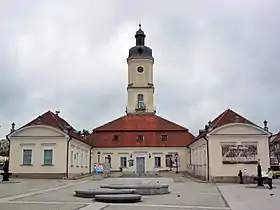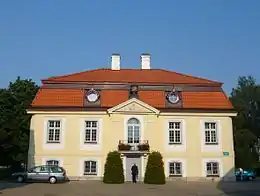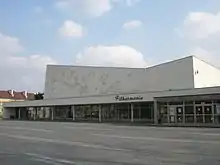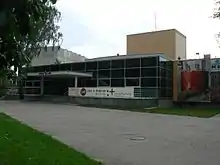Culture in Białystok
Białystok is one of the largest cultural centers in the Podlaskie Voivodeship. The attractions include performing arts groups, art museums, historical museums, walking tours of architectural / cultural aspects and a wide variety of parks and green spaces. Białystok in 2010 was on the short-list, but ultimately lost the competition, to become a finalist for European Capital of Culture in 2016.[1]
- This is a sub-article to Białystok
Performing arts
The city has a number of performing arts facilities including:
- Białystok Puppet Theatre (Polish: Bialostocki Teatr Lalek), established in 1953, is one of the oldest Polish puppet theaters.[2] The facility is located at Kalinowskiego 1 in Białystok. The repertoire includes performances for both children and puppet adaptations of world literature for adults.[2] Because of the high artistic level of productions, the theater has been recognized as one of the best puppetry arts centers in Poland.[2]
- Aleksandr Węgierki Drama Theatre in Białystok. Housed in a building designed by Jaroslaw Girina, built in the years 1933-1938.[3]
- Podlaska Opera and Orchestra
Museums
There are a number of museums in the city including:
- Historical Museum in Białystok (Polish: Muzeum Historyczne w Białymstoku) is part of the Podlaskie Museum.[4] The facility has a rich collection of archival materials and iconography illustrating the history of Białystok and Podlasie, and a number of middle-class cultural relics, especially in the field of craft utility.[4] There are also the Numismatic Cabinet of the collection of 16 000 coins, medals and securities.[4] The museum is in possession of the only collections in the country memorabilia connected with the Tatar settlement on the Polish-Lithuanian-Belarusian region.[4]
- Army Museum in Białystok (Polish: Muzeum Wojska w Białymstoku) was established in September 1968 as a branch of the Podlaskie Museum to house the research and collections of many people connected with military history of north-eastern Poland.[5]
Białystok, as the seat of the Voivodeship, is one of the largest cultural centers in the north-eastern Poland. It works in the Museum of the largest in the province of Podlaskie, with branches in Białystok (Historical Museum, the Museum of Sculpture Alfons Karny, Bialystok Village Museum). In Bialystok, there are also: Army Museum and the Museum of Natural History, University of Bialystok. There's also one of the best Polish contemporary art gallery - Gallery Arsenal. The second gallery is a municipal gallery to them. Sleńdzińskich, Poland has the largest collection of art and memorabilia archive Polish family of artists from Vilnius. In addition, there are 19 private art galleries here.
Białystok Cultural Center (Legionowa 5, 15-281 Białystok)[6]
The Białystok Cultural Center was established in 1975. It organize over 200 events, festivals and local activities every year. One of the most popular event is Days of Bialystok which includes big cultural events like jazz concerts, dance and theater performances, and outdoor events. Another large festival is the Days of Modern Art festival - two weeks of movie, music, photographic, comic art, animation and theater events. From over 30 propositions about 25 are organizing by our center and the rest are mostly organized by Arsenal Gallery. Twice a month people interested in other culture/nations are participating in Globetrotter's World series - a meeting with many attractions: dance workshops, original food tasting, guest from all over the world including guest from different embassies. The biggest cultural event in autumn season is Autumn with Blues.
Śródmieście Culture House (Kilińskiego 13, 15-089 Białystok)[7]
Śródmieście ("Downtown") Culture House was created by Resolution of the City of Bialystok dated. 4 February 1991. It a local cultural institution that operates as a center of art education and carries out tasks in the fields of education, cultural education, the dissemination of culture among children and adolescents and adults.
Youth Culture Club (15-201 Białystok Warszawska 79)[8]
The Youth Culture Club in Bialystok is an extra-curricular education institution. It implements a program of teaching - educational as the statute, the work plan developed by the Teachers, the suggestions of the Parent Council and Youth Council, and according to the needs of the local community. It was established in 1983. The focal point of the work with youth is the interpretation of art and replenishment activities, education, polytechnic and sports, which enables the full development of personality of a young minds.
Białystok Puppet Theatre, Kalinowskiego 1, 15-875 Białystok[9]
Sleńdzińskich Gallery (municipal institution presenting Vilnius heritage of Sleńdziński family), Waryńskiego 24A, 15-461 Białystok[10]
The Arsenał Gallerył (municipal gallery of modern art) A. Mickiewicza 2 15-232 Białystok[11]
The Army Museum, Kilińskiego 7, 15-089[12]
Libraries
In Białystok operates several libraries. The biggest of these is Podlaska Library (Polish: Książnica Podlaska) and the Białystok University Library. The elderly and the disabled free use of the Library Foundation for Education and Creativity, which offer the service "phone book" dedicated to those who are not able to reach out personally to hire. Other cultural institutions include the Białostocki Cultural Center, Orthodox Cultural Center, the Center for Esperanto. Ludwik Zamenhof, the House of Culture "Downtown", Voivodeship Center of Cultural Animation and Youth Culture
Parks and green spaces
Approximately 32% of the city is occupied by parks, squares and forest preserves which creates a unique and healthy climate.[13] The green spaces include:
- Branicki Palace (Polish: Pałac Branickich) is a historical edifice and 9.7 ha (24 acres) park in Białystok. It was developed on the site of an earlier building in the first half of the 18th century by Jan Klemens Branicki, a wealthy Polish–Lithuanian Commonwealth hetman, into a residence suitable for a man whose ambition was to be elected king of Poland.[14] The palace complex with gardens, pavillons, sculptures, outbuildings and other structures and the city with churches, city hall and monastery, all built almost at the same time according to French models was the reason why the city was known in the 18th century as Versailles of Podlaskie (Polish: wersalem podlaskim).[15][16]
- Planty is a 14.94 ha (36.9 acres) park created between 1930–1938, under the auspices of the then Voivode Kościałkowskiego Mariana Zyndrama in the areas adjacent to Branicki Palace.[17] The modernist composition of the park was designed by Stanislav Gralla.[18]
Approximately 32% of the city is occupied by green areas. Parks and squares and 1,779 ha of forest are located within the city which creates a unique and healthy climate. Within Bialystok, there are two nature reserves with a total area of 105 ha, that are part of the Knyszyn Forest. Such a location of nature reserves in the immediate vicinity of the city is unique. Because of these advantages in 1993 as the first city of Bialystok in Poland, was admitted to the International Network of Healthy Cities project conducted by the World Health Organization.[19]
Within the town there are two nature reserves: "Las Zwierzyniecki" Nature Reserve[20] and "Antoniuk" Nature Reserve.[21]
.jpg.webp) Planty park
Planty park Branicki Palace and Gardens
Branicki Palace and Gardens Garden of the Branicki Palace in Białystok
Garden of the Branicki Palace in Białystok
Architecture
The various historically driven changes have had a significant influence on the architectural space of the city. Most other Polish cities have suffered similarly, but the processes in Białystok, have had a particularly intense course. Numerous historic works of architecture no longer exist, while many others have been rebuilt to their original configuration. Few of the city's historic buildings have been preserved - the sights are merely an echo of the old historical shape of Białystok.[22]
 Bialystok City Hall
Bialystok City Hall Fountain at the Market Square
Fountain at the Market Square Old houses on Kosciusko's Market in Białystok
Old houses on Kosciusko's Market in Białystok Guest palace Branicki in Bialystok
Guest palace Branicki in Bialystok Hasbach Palace in Białystok
Hasbach Palace in Białystok Lubomirski Palace in Bialystok
Lubomirski Palace in Bialystok.jpg.webp) Citron's Palace in Białystok
Citron's Palace in Białystok.JPG.webp) Nowik's Palace in Białystok
Nowik's Palace in Białystok
 Pałacowa Street
Pałacowa Street Ciepła Street
Ciepła Street.jpg.webp) The papal altar at the Shrine of Divine Mercy
The papal altar at the Shrine of Divine Mercy
Monuments
- In memory of victims of the Polish-Bolshevik war[23]
- "42nd Infantry Regiment" of Jan Henryk Dabrowski monument[24]
- Armia Krajowa monument[25]
- In memory of heroes from Białystok Land in World War II[26]
- Jadwiga Dziekońska (soldier of Armia Krajowa) monument[27]
- In memory of murdered Poles in Katyn[28]
- Marshal Józef Piłsudski monument[29]
- Jerzy Popiełuszko monument[30]
- Polish Army in western Europe (during World War II) monument[31]
- Solidarność monument[32]
- In memory of Poles deported to Siberia[33]
- In memory of murdered Jews in the Great Synagogue (WWII)[34]
- In memory of victims of the Ghetto uprising in Białystok[35]
- Defenders of Białystok monument (WWII)[36]
- Ludwik Zamenhof monument[37]
 The monument of Polish Armed Forces in the West
The monument of Polish Armed Forces in the West Memorial in honor of those killed in the Polish-Soviet War in 1920
Memorial in honor of those killed in the Polish-Soviet War in 1920
Events
A number of recurring cultural events happen every month in Białystok. The list includes, but is not limited to:
- Presentation of nativity scenes (January)
- Carnival - A Voivodeship Review of Dancing Companies (January)
- Szorty - the independent film festival (February)
- National Festival of Belarusian Song (February)
- Białystok Music Spring (March)
- Documentary Film Festival (March)
- Golden Shoes Ballroom Dancing Tournament (March - April)
- KOPYŚĆ Festival of Sailor Songs (March - April)
- Easter Festival (Easter)
- The International Festival of Orthodox Church Music (May)
- Days of Contemporary Art (May - June)
- Juvenalia Students Festival (May - June)
- Summer Divertimento, Sunday Chamber Music (May, September)
- Jazz Deptak, jazz concerts (May, September)
- Days of Białystok (June)
- Jarmark na Jana - the craft fair (June)
- Cathedral Organ Concerts (July - August)
- Białystok Orthodox Music Days (September)
- The Podlaskie Trade Fairs of folk sculpture, double warp textiles and folk smithing (September)
- European Cinema Forum (September)
- Białystok Summer Film Festival (August)
- Russian Culture Days (October)
- Papal Days (October)
- Białystok Folk Songs (September - October)
- Festival of Ukrainian Culture - the Podlasie Autumn (October)
- All Saints Day with the Blues (November)
- Autumn with the Blues festival (December)
- KRESY - Poetry reciting contest for Poles living abroad (December)
- Quo vadis - festival of Christian art
References
- "Białystok 2016" (in Polish). Retrieved 2011-04-15.
- "Białystok Puppet Theater" (in Polish). Archived from the original on 2008-05-15. Retrieved 2011-04-15.
- "Z sesji miejskiej. PiS przegrał z Węgierką" (in Polish). Retrieved 2011-04-15.
- "Oficjalna strona Muzeum Podlaskiego" (in Polish). Archived from the original on 2011-02-19. Retrieved 2011-04-15.
- "Muzeum Wojska w Białymstoku" (in Polish). Retrieved 2011-04-15.[ ]
- "Białystok Cultural Center". Bok.bialystok.pl. Retrieved 2012-08-13.
- "Śródmieście Culture House". Dksbialystok.pl. Retrieved 2012-08-13.
- "Youth Culture Club". Mdk.bialystok.pl. Retrieved 2012-08-13.
- "btl.bialystok.pl" (in Polish). btl.bialystok.pl. Retrieved 2012-08-13.
- "slendzinski.art.pl". slendzinski.art.pl. Retrieved 2012-08-13.
- Piotr Nalewajko, [email protected]. "galeria-arsenla.pl". Galeria-arsenal.pl. Retrieved 2012-08-13.
- Białystokwww.mwb.com.pl
- "Białystok portal miejski. Białostockie parki" (in Polish). Archived from the original on 2009-02-18. Retrieved 2011-04-15.
- "Podlaski Wersal Branickich". palac.amb.edu.pl (in Polish). Archived from the original on 2011-07-16. Retrieved 2009-11-26.
- "Widok zespołu parkowo - pałacowego z "lotu ptaka"" (in Polish). Archived from the original on 2011-05-04. Retrieved 2011-04-15.
- "Zielony Białystok - Ogród Branickich" (in Polish). Archived from the original on 2011-08-17. Retrieved 2011-04-15.
- "Rejestr zabytków województwa podlaskiego" (PDF) (in Polish). 2011-03-25.
- "Akcja Planty, czyli jak za dawnych lat" (in Polish). Retrieved 2011-04-15.
- "Zielone Płuca Polski". Archived from the original on 2011-08-17. Retrieved 2011-02-07.
- "Centralny Rejestr Form Ochrony Przyrody" (in Polish).
- "Centralny Rejestr Form Ochrony Przyrody" (in Polish).
- "Białystok 2006-2010" (in Polish). Archived from the original on 2011-08-16. Retrieved 2011-05-23.
- "Internet Archive Wayback Machine". Web.archive.org. 2007-09-27. Archived from the original on February 16, 2006. Retrieved 2012-08-13.
- "Internet Archive Wayback Machine". Web.archive.org. 2005-12-15. Archived from the original on December 15, 2005. Retrieved 2012-08-13.
- "Internet Archive Wayback Machine". Web.archive.org. 2006-01-07. Archived from the original on January 7, 2006. Retrieved 2012-08-13.
- "Internet Archive Wayback Machine". Web.archive.org. 2006-01-12. Archived from the original on January 12, 2006. Retrieved 2012-08-13.
- "Internet Archive Wayback Machine". Web.archive.org. 2007-09-27. Archived from the original on February 16, 2006. Retrieved 2012-08-13.
- "Internet Archive Wayback Machine". Web.archive.org. 2007-09-27. Archived from the original on February 16, 2006. Retrieved 2012-08-13.
- "Internet Archive Wayback Machine". Web.archive.org. 2006-10-20. Archived from the original on October 20, 2006. Retrieved 2012-08-13.
- "Internet Archive Wayback Machine". Web.archive.org. 2007-09-27. Archived from the original on July 21, 2002. Retrieved 2012-08-13.
- "Internet Archive Wayback Machine". Web.archive.org. 2006-11-01. Archived from the original on November 1, 2006. Retrieved 2012-08-13.
- "Internet Archive Wayback Machine". Web.archive.org. 2006-02-16. Archived from the original on February 16, 2006. Retrieved 2012-08-13.
- "Internet Archive Wayback Machine". Web.archive.org. 2005-11-18. Archived from the original on November 18, 2005. Retrieved 2012-08-13.
- "Internet Archive Wayback Machine". Web.archive.org. 2006-01-12. Archived from the original on January 12, 2006. Retrieved 2012-08-13.
- "Internet Archive Wayback Machine". Web.archive.org. 2006-02-16. Archived from the original on February 16, 2006. Retrieved 2012-08-13.
- "Internet Archive Wayback Machine". Web.archive.org. 2007-09-27. Archived from the original on February 16, 2006. Retrieved 2012-08-13.
- "Internet Archive Wayback Machine". Web.archive.org. 2005-12-15. Archived from the original on December 15, 2005. Retrieved 2012-08-13.




